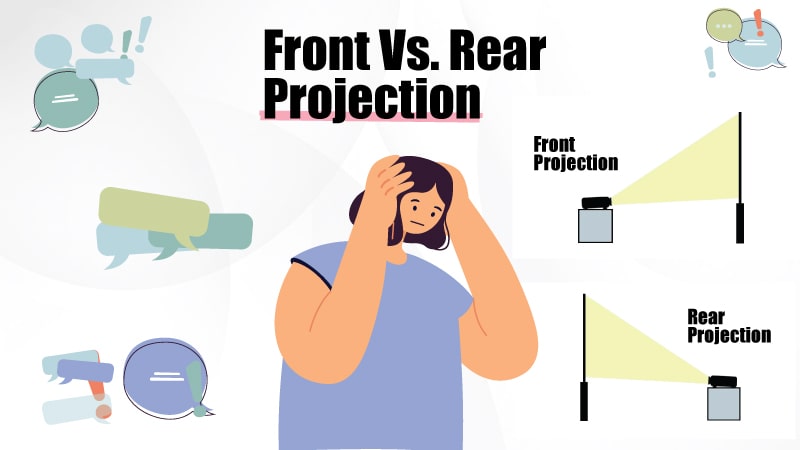Confused between the front and rear projections? You need to remember a few factors when deciding which works best for you.

If you are considering purchasing a projector for yourself for the first time, you might be scratching your head when choosing between front and rear projections.
Even though you may know that both front and rear projections have advantages and disadvantages, opting for one sometimes gets confusing.
In this article, I have explained the pros and cons of using both front and rear projections and how to determine the best fit for you. I am 100% sure, by the end of this article, you will be able to decide which type of projection is ideal for you.
So,
What are these screen types? Front Vs. Rear Projections
What is Front Projection?
When I say front projection, I mean the image is projected on the screen from the front side.
To be precise, in this type of projection, the projector is kept right in front of the screen at a distance, and the light from the projector hits the screen and is reflected in the audience, because of which the audience sees a bright and sharp image on the screen.
In most cases, the projector is either mounted on the ceiling or kept behind the audience for better projection.
What is Rear projection?
On the contrary, in the case of rear projection, the image on the projector screen is projected from the back of the screen.
In most cases, the audience does not see the projector as it is mostly kept behind the proctor screen.
Now that you know the basic difference between the two, let me walk you through the pros and cons of both front and rear projections to help you understand which is better for you.
Front Projection: Pros & Cons
Pros
1. The Image quality is better
The primary benefit of using front projection is that you get crisp images that are clearer than you get through rear projection. This is possible because, in front projection, the amount of light absorbed by the screen is much less than the amount of light reflected toward the audience. Therefore, the audience sees bright, clear, and sharp images.
2. You don’t need a strong projector
The second reason most people prefer front projection is that you do not need an expensive projector with a strong projection for decent image quality. Almost all types of projectors can be used in front projection, even if they are not strong enough. Therefore, the price you pay is also reasonable.
3. You can view the images from almost all angles
Front projection allows you to view images from different angles. This means you don’t need to worry about whether the people in the room can view the image. Therefore, using front projection, you can easily address large crowds.
Cons
1. You need adequate space to project images
One of the most apparent disadvantages of front projection is you need adequate space. Since most projectors used for front projection need to be kept at least a few feet away from the screen (unless they’re short-throw and ultra-show-throw projectors), the room you are using for projection needs to be spacious.
So that you can comfortably accommodate your audience and place the projector at the right distance, cramped rooms are not ideal for front projection if you plan to use normal throw projectors.
2. In case of congested areas
If you feel people are getting in the way of projection and affecting the image quality, you must mount the projector on the wall. At times wall mounting will cost you additional time and money. Therefore, it is considered a disadvantage.
3. You need to control the ambient light
Finally, you need to take control of the ambient light to ensure the image quality does not suffer during front projection. Too much ambient light can affect the sharpness of the image. It is best if you are projecting images in a dark room. Therefore, when using front projection, you must use curtains to block too much ambient light entering the room.
Rear Projection: Pros & Cons
Pros
1. The projector is invisible
The best thing about using rear projection is that you do not see the projector anywhere because it’s mostly placed behind the screen. Therefore, it allows more space for your audience to stand in front of the screen and look neat and professional.
2. Ambient light is not a reason to worry
The second biggest advantage of using rear projection is that you do not need to worry about the ambient light or use the projector in a dark room. Since the projector projects the image from behind the screen, the screen absorbs most of the reflection.
Therefore, the ambient light does not affect the image quality. As a result, you don’t need to switch off lights or draw curtains to block ambient light when using rear projection.
3. It is ideal for professional use
As we have stated above, since the projector is invisible and it is not necessary to block the ambient light rear projection is ideal for professional use.
Cons
1. You need a costly and strong projector
Well, this is one disadvantage of rear projection that cannot be ignored. The technology used in rear projection demands the use of powerful projectors.
Mid-range projectors can’t project clear images through rear projection. Therefore, pick a powerful high-end projector if you plan to use a projector for rear projection.
2. You cannot view images from every angle
Another drawback of using rear projection is that you cannot view the image clearly from all angles. Since the projector reflects the image from behind the screen, the viewing angle is also compromised.
Therefore, to ensure everyone can see the screen effortlessly, you must arrange proper seating arrangements in the room.
3. High Gain Material is needed for Rear Projections
Not all screens are suitable for rear projection. If you wish to make the most of it, I recommend using high-gain screens so that your image appears crisp and sharp. Because this incurs additional costs, it is also considered one of the drawbacks of using rear projection.
3. Space requirement in the rear projection
Most importantly, it would help to have a good space behind the screen to place the projector. Therefore, you should make a few adjustments when setting the projector screen for rear projection.
Now that you are thorough with the benefits and drawbacks of using both front and rear projections, let me tell you how to decide which works best for you.
If you ask me how to determine which would be ideal for you, the best way to find this is by analyzing your environment.
- Where are you planning to keep the projector?
- How many people are you planning to accommodate?
- What is the purpose of your projection, and how much space do you have?
These are vital questions you must ask yourself when deciding which to buy.
To make things easy for you, I have categorized these questions into some basic factors you need to consider while taking the final call.
Crucial Factors: Deciding buying factors that will tell you which projection is ideal for you
Size of the Room
First, if you want to know which projection is ideal for you, consider the size.
In both cases, the size of the room where you wish to use the projector matters because, in front projection, the projector needs to be kept a few feet away from the projector. There should be adequate space for your audience to stand similarly.
Regarding rear projection, you must ensure adequate space behind the screen; if it is not ideal for your audience, it could be good enough to place your projector.
Therefore, when you place the projector and set up your screen, analyze the amount of leg and backspace to determine which projection will work best for you.
Usability
If you are a person who is not very tech-savvy, then rear projection might confuse you because the setup and installation are a little complicated compared to front projection. You will need a special high-gain screen and a good high-end projector to make sure you see clear images on the screen through rear projection.
On the contrary, installing a projector screen and setting up a projector for front projection is way easier. You need to follow a few basic steps and are good to go. Therefore, if you consider ease of use, you should opt for front projection.
Number of people
The audience strength also helps you decide which type of projection would be ideal for you. For example, if you have a limited audience and the room is small, the rear projection is good as you get a lot of leg space in front of the screen. On the contrary, if you need to address a large crowd, the front projection would be most suitable because you can view the screen clearly from all angles.
Ambient Light
Nevertheless, the environment also decides when you are stuck between rear or front projection. For example, the amount of light entering the room. In the case of rear projection, the ambient light does not make much difference. Your image quality does not change with daylight, but if you intend to use front projection, you must control the ambient light. You can turn off the lights or turn down the curtains to ensure that too much ambient light does not ruin your image quality.
Cost
Last but not least, the cost is also a factor that must be considered. The major reason is if you are planning to use rear projection, ensure you get a powerful projector. Be prepared to spend a few extra bucks.
But if you have financial constraints and do not want to compromise on image quality, prefer front projection.
Can Your projector project image both ways?
You might wonder whether you can use the same projector for front and rear projection or invest in a different one. Right? The good news is that almost all projectors are designed to serve you both ways. So, investing in two different types of projectors is not required.
You need to keep two things in mind. First, the projector you are using for both types of projection should be strong.
You can use a good cheap projector if you use it for front projection, but if you tend to change your mind, make sure your projector is strong enough to work both ways. And secondly, the screen used to project images should be a high-gain screen to work best both in the case of front and rear projections.
Final Takeaway: The Difference Between Front And Rear Projections?
Therefore, if you cannot decide which type of projection is ideal for you, consider the size of the room, the projector cost, convenience, audience strength, and the amount of light entering the room.
These factors will help you decide faster and better. And, if you wish to use a projector both ways, ensure the projector is strong enough and you own a high-gain projector screen.
If you still have doubts about which projection is ideal, contact me. I will be happy to help.
Sources:

